 Raise a Glass to Freedom
Raise a Glass to Freedom


12 min read
The history of this remarkable movement is even stranger and more incredible than depicted in the hit series Ridley Road.
The BBC television series Ridley Road, which is also airing on PBS in the United States, presents a fictionalized version of real events in 1960s London. As PBS puts it, “Ridley Road tells the story of Vivien Epstein, a young Jewish woman who after falling in love with a member of the ‘62 Group’, rejects her comfortable middle-class life in Manchester and joins the fight against fascism in London."
The ‘62 Group was a real-life Jewish anti-fascist outfit. The popular series is based on the 2014 novel by the same name by Jo Bloom. Ridley Road refers to a street in northeast London in a neighborhood that used to be heavily Jewish (and still is home to an Orthodox Jewish community today). In the series, Vivien goes undercover in Britain’s fascist movement, the National Socialist Movement (NSM). In real life, the ‘62 Group comprised dozens of incredibly brave British Jews. The history of this remarkable movement is even stranger and more incredible than fiction.
Many thousands of British Jewish servicemen and women contributed to the fight against fascism during World War II. After the war’s end in 1945, as these ex-soldiers returned home – many to the East End of London, which had a sizeable Jewish community – they were in for a rude shock. As journalist Marcus Barnett has described, “Within months of the war’s end, fourteen fascist groups and at least three (fascist) bookshops operated openly across the city (London). Newspapers with names like Britain Awake and The Patriot were readily available on street corners. Most alarmingly of all, fascists began staging outdoor rallies in the densely-Jewish East End once again”.
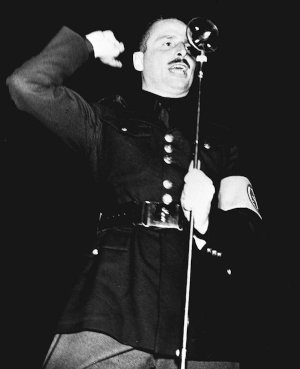 Sir Oswald Mosley at a far right rally
Sir Oswald Mosley at a far right rally
Each Sunday evening Oswald Mosley, a British aristocrat and former Member of Parliament who became an ardent fascist, held rallies at the popular Ridley Road Market. Sometimes dubbed “Yidley Road” because so many Jewish shopkeepers ran stalls there, Ridley Road Market was a vibrant outdoor street market. (It still remains today, in a much smaller form.) Fascists had long targeted the vibrant thoroughfare and market because it was seen as a Jewish center within London. British fascists shouted “Heil Mosley” in the market and loudly sang the Nazi German national anthem.
Morris Beckman, who died in 2015, was a WWII veteran who described the sickening way he and other Jewish ex-servicemen witnessed enthusiastic support for fascism after the war. “We would see newsreels in the cinemas of piles of Jewish men, women and children being bulldozed into lime pits in the concentration camps – and then pass an outdoor fascist meeting, or see swastikas painted in the street and antisemitic posters in Jewish areas such as Hackney, Edgeware or Stamford Hill.”
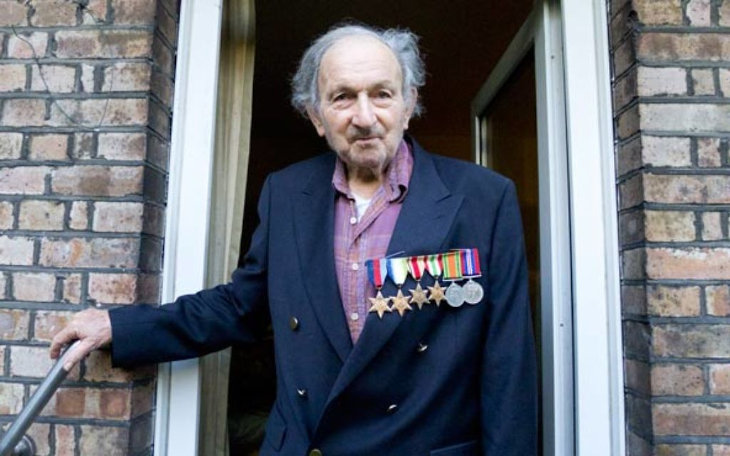 Morris Beckman, a founding member of the British anti-fascist 43 Group (Photo credit: Janette Beckman)
Morris Beckman, a founding member of the British anti-fascist 43 Group (Photo credit: Janette Beckman)
Jules Konopinski was another British Jew who had lost nine uncles and aunts in Nazi death camps. He later recalled, “Openly in the streets you had public meetings shouting out the same antagonism and the same filth as before the war… and now even worse – they were saying the gas chambers weren't enough.”
By April of 1946 – less than a year after Hitler’s defeat – these Jews and others had had enough. They arranged a meeting in Maccabi House, a Jewish sports club in the Hampstead neighborhood of north London, to decide how to fight back. Thirty-eight men who’d fought in the war showed up for the meeting, and five women attended. Almost all of the people present were Jews, though the son of one left-wing Labour MP also turned up to pledge his support.
The Jews of London needed a fighting force that would stand up to Nazi thugs.
The meeting was led by Alec Black, a British Jew who’d fought in the Normandy invasion in France. The Jews of London needed a fighting force that would stand up to Nazi thugs. The men and women assembled in Maccabi House would have two goals: opposing Nazis – with force, if need be – and pressuring British lawmakers to pass laws making racial incitement illegal. Anyone joining this group would face danger and the potential for arrest and long jail sentences, Black explained. Anyone who wanted to leave was welcome to do so. The crowd remained utterly still. Nobody walked out.
The group adopted a name, the 43 Group, after the number of people attending that first meeting. Soon their ranks swelled; 300 people joined within days. They began to fight back when Nazis attacked them. When a fascist ran through the Jewish neighborhood of Stamford Hill slashing people with a razor blade, two members of the 43 Group beat him unconscious. 43 Group members would infiltrate Nazi rallies, heckling speakers and fighting Nazi thugs.
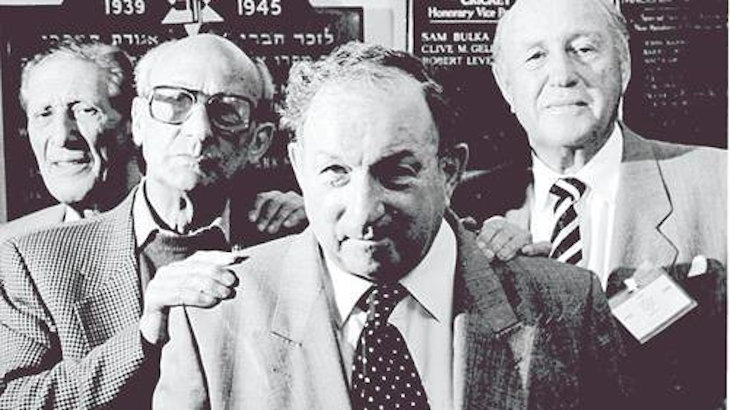 43 Groupers (l to r) Leonard Sherman, Alex Carson, Morris Beckman and Gerry Flamberg at a 50th anniversary reunion in 1996
43 Groupers (l to r) Leonard Sherman, Alex Carson, Morris Beckman and Gerry Flamberg at a 50th anniversary reunion in 1996
Within a year, the 43 Group had swelled to over a thousand members and the group had attracted the public support of some left-wing Labour MPs.
On June 1, 1947, the British Union of Fascists announced a major rally in Ridley Road. The 43 Group decided to counterattack, dubbing their plans the “Battle for Ridley Road”, and preparing to break up the rally with battle-plan precision. As they approached the rally, the 43 members were shocked: the crowd was huge, and police were guarding the fascists. Nevertheless, the 43 Group sprang into action, infiltrating the crowd and beginning to heckle.
The fascists started shouting out particularly offensive and antisemitic taunts, then fighting broke out. Morris Beckman described the commotion in his memoir: “A young fascist about 18 years of age appeared in front of me and called me a “(obscenity) Jew (obscenity),” catching my left thigh with a nearly well-aimed kick. I hit his nose square on and it spurted blood… I kicked his backside as hard as I could and he staggered off. A hard blow landed smack on my right ear and completely unbalanced me…
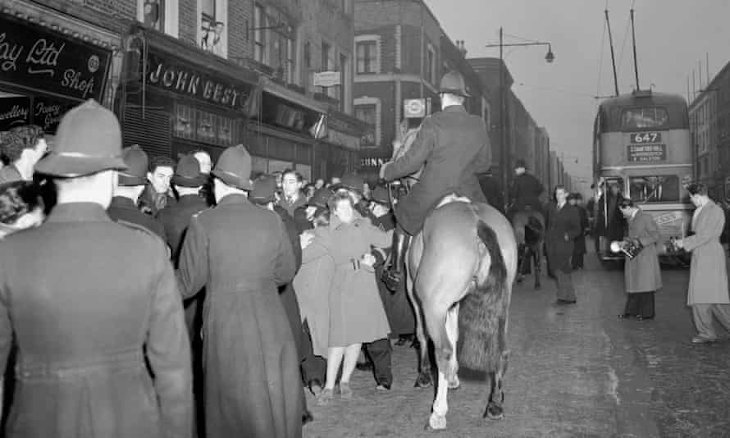 Police break up clashes between followers of Sir Oswald Mosley and protestors in Ridley Road on 20 March 1949. Photograph: PA
Police break up clashes between followers of Sir Oswald Mosley and protestors in Ridley Road on 20 March 1949. Photograph: PA
“For a moment, I was dazed, disorientated. My assailant was about to close and finish me off when Sam grabbed him around the neck and pulled him to the ground. Then Sam jumped on him. The genial, good-humored Sam said, ‘I’m just breaking the bastard’s ribs so he won’t attend any more meetings.”
One member was Vidal Sassoon, who would go on to fame later in life as a world-famous hairdresser and businessman.
One member was Vidal Sassoon, who would go on to fame later in life as a world-famous hairdresser and businessman. In 1946 he was a 17-year-old London Jew and a 43 Group member. The 43 Group fighters “did not intend to allow the fascists ever again to rule the streets of London,” he later explained. “And so it began. We had turned the other cheek for the last time and, as a 17-year-old recruit, I was proud to be involved.”
Soon, the 43 Group was breaking up about fifteen fascist meetings each week. In 1947, members fought against fascists in Manchester, Liverpool, and other cities as well as London. By the late 1940s, however, Oswald Mosley was losing his grip on the movement. Public sentiment was turning, as well. Increasingly, print-makers were refusing to print fascist material for rallies. In 1950, the 43 Group disbanded.
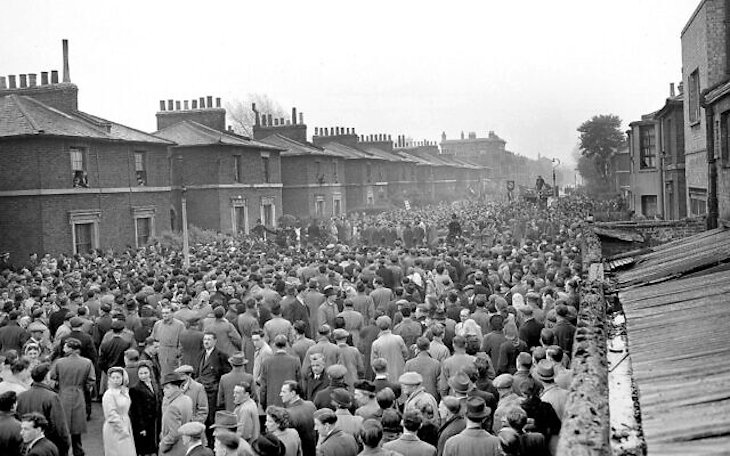 In background standing atop his broadcast van, Sir Oswald Mosley, fascist leader, speaks during a May Day rally in London’s East End, May 1, 1948. (AP Photo)
In background standing atop his broadcast van, Sir Oswald Mosley, fascist leader, speaks during a May Day rally in London’s East End, May 1, 1948. (AP Photo)
In the early 1960s, British fascism raced a resurgence. In the words of Gerald Ronson, a founder and Chairman of Britain’s Community Security Trust (CST) – and an early member of the 62 Group – British Jews in the 1960s wanted to form an organization similar to the 43 Group to fight back.
“Very aggressive, extreme right-wing antisemitic gangs had been a problem in the UK for a long time,” Ronson explained. “To combat them, a bunch of Jewish soldiers coming home from the war formed the 43 Group and used to go around at night painting anti-fascist slogans. As those men got older, and young men my own age took up the cause, a new group was formed, called the 62 Group.”
The turning point was a huge fascist rally held in 1962 in Trafalgar Square in the heart of London. The leader was Colin Jordan, a leader in Britain’s fascist movement (and the husband of Francoise Dior, niece of fashion designer Christian Dior). After founding a “Nationalist Club” in college, he eventually changed the name to National Socialist Movement (NSM) on April 20, 1962, Hitler’s birthday.
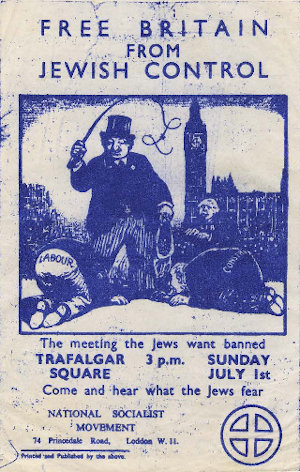 Flyer for neo-Nazi rally in 1962
Flyer for neo-Nazi rally in 1962
On July 1, 1962, the NSM’s rally began. Jordan mounted a stage wearing a brown shirt, boots and an armband featuring a pagan sun wheel. Banners behind him proclaimed “Free Britain from Jewish Control'' and “Britain Awake”. Jewish and Communist groups were present to protest, and the rally degenerated into a melee. However, Oswald Mosley stepped in and announced an even larger fascist rally would take place in London three weeks later. Britain’s Jews knew they had to act.
Meeting in the Ephra Road Synagogue in southeast London, a group of local Jews decided that they needed to stand up and fight British Nazis. The 43 Group was their direct inspiration. They dubbed themselves the “62 Committee” (later changed to 62 Group) and got to work, infiltrating the NSM to gather intelligence about their activities.
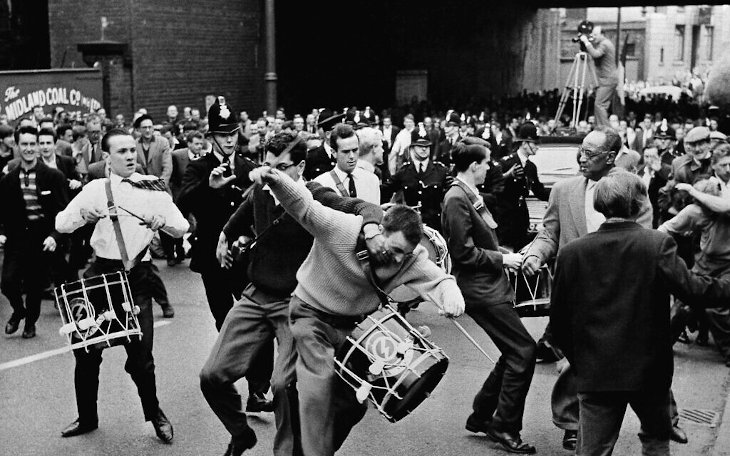 An irate spectator attacks a drummer of British fascist leader sir Oswald Mosley, leader of the extremist right-wing British union movement, during a march through Manchester, England on July 29, 1962.
An irate spectator attacks a drummer of British fascist leader sir Oswald Mosley, leader of the extremist right-wing British union movement, during a march through Manchester, England on July 29, 1962.
One early member was Gerry Gable, who later edited the anti-fascist magazine Searchlight. He recalled that the 62 Group differed in some key ways from the 43 Group. By the 1960s, British fascists were also targeting West Indians and Blacks, and the anti-fascist fight addressed these issues as well. He described one 62 Group operation:
“When Mosley announced a march...it was decided to head him off by seizing his HQ in Victoria (an area of central London). The plan was to gain entry to the building by means of two attack groups. The first consisted of a couple of our toughest infiltrators… They were blonde, blue eyed and had documentation and party badges that got them inside. Then, while one of them engaged the security guards, the other opened the front door and let in another six or seven tough guys, who locked the door behind them.”
The operation went according to plan and the 62 Group members destroyed much of the fascist organization’s material. While some 62 Group members engaged in fierce fighting with the fascists, others headed down to the basement where documents and other items were stored. “The idea was not to steal anything, as via our infiltrators we already had copies of their membership files and other important documents. The task was to destroy everything that made their HQ work. It was very bloody.” The 62 Group won the fight, leaving the fascists tied up and their headquarters largely wrecked.
As Britain’s Community Security Trust, an organization that was founded by 62 Group member Gerald Ronson, explains, the 62 Group filled a vital need at the time.
“Police intelligence on the far right in the 1960s was virtually non-existent, but 62 Group information gathering was so good that it led...to the apprehension and conviction of a (fascist who set fire to a London yeshiva), and the arrests of several others who had perpetrated hate crimes. It was particularly efficient at unmasking the violent plans of Jordan’s National Socialist Movement, who aspired to develop a neo-Nazi international, and its paramilitary...offshoot.”
Gerald Ronson became the chief fundraiser for the 62 Group. By the 1970s, the British Jewish community’s priorities were changing. Middle Eastern terrorism was a growing threat, and it required different strategies and resources to those used for fighting fascists. “I was beginning to think that being hooligans to fight hooligans wasn’t the smartest way we could fight the enemy,” he later recalled.
 Gerald Ronson
Gerald Ronson
“I was thinking that we needed to beat the enemy by being more sophisticated than them. That meant setting up a new organization. It had to be more than 200 well-meaning tough boys behaving in an undisciplined fashion. It had to look for long-term solutions and I felt that the greater Jewish community in Britain should fund it.”
"Britain needs to take a long look into its brushes, and obsession, with fascism."
In the 1970s, the 62 Group ceased functioning and a host of British Jewish communal organizations sprung up in its place, including the Community Security Organization of the Board of Deputies of British Jews and the Community Security Trust, which works closely with the police to provide safety, security, and advice to the Jewish community in the UK.
The current television show Ridley Road is ensuring that the current generation remembers the bravery of the 62 Group members today. Executive producer Nicola Shindler explains that working on Ridley Road has been “incredibly uncomfortable as a Jewish woman. I wasn’t aware of how prevalent these views were in the 1960s and I did find it really shocking.”
British Jewish actress Tracy-Ann Oberman appears in the show as Nancy Malinovsky, the wife of a 62 Group leader. “At a time when we are reappraising British history through the eyes of minorities (related to) colonialism and slavery, Britain also needs to take a long look into its brushes, and obsession, with fascism,” she’s explained. “Ridley Road is a reminder that this resurgence of Jew-hate happened again in 1962, and we have forgotten that fascists held mass marches against Jews, set fire to synagogues and attacked Jewish people… And today, our community needs to know how vulnerable we were.”

The article ended incorrectly; Not were but remain and are vulnerable. Ridley Road, and Hackney has been filled with hate for Jews by pro-Palestinianism.
Ironic - the Jews fought for the right of Muslims, Afro-Caribbeans, minorities to come and live in Britain. The very people the Jews helped have turned on them...